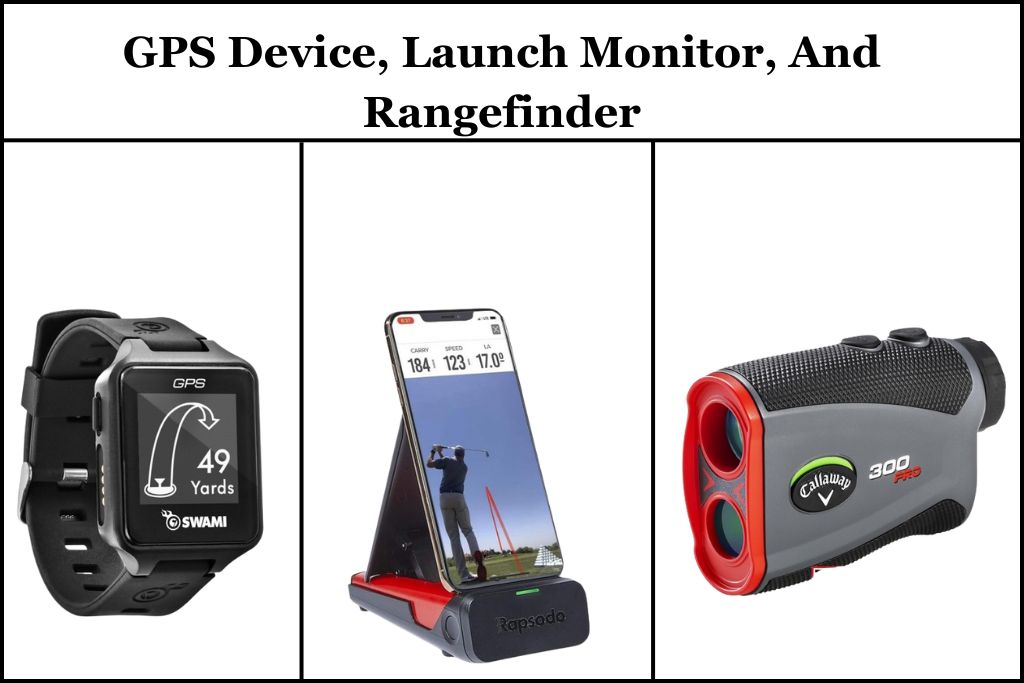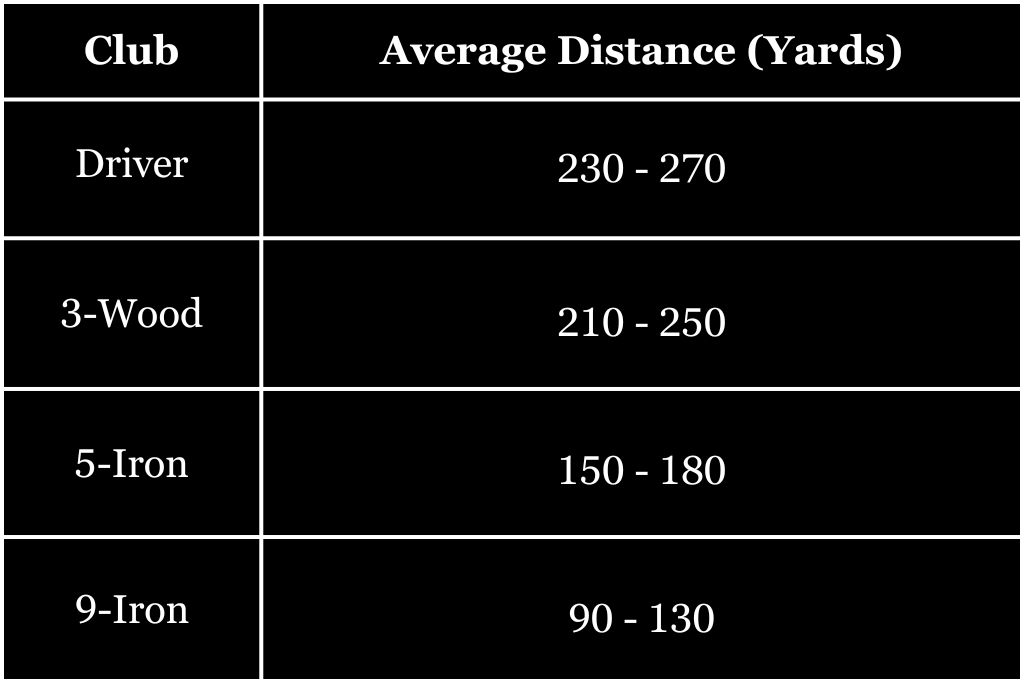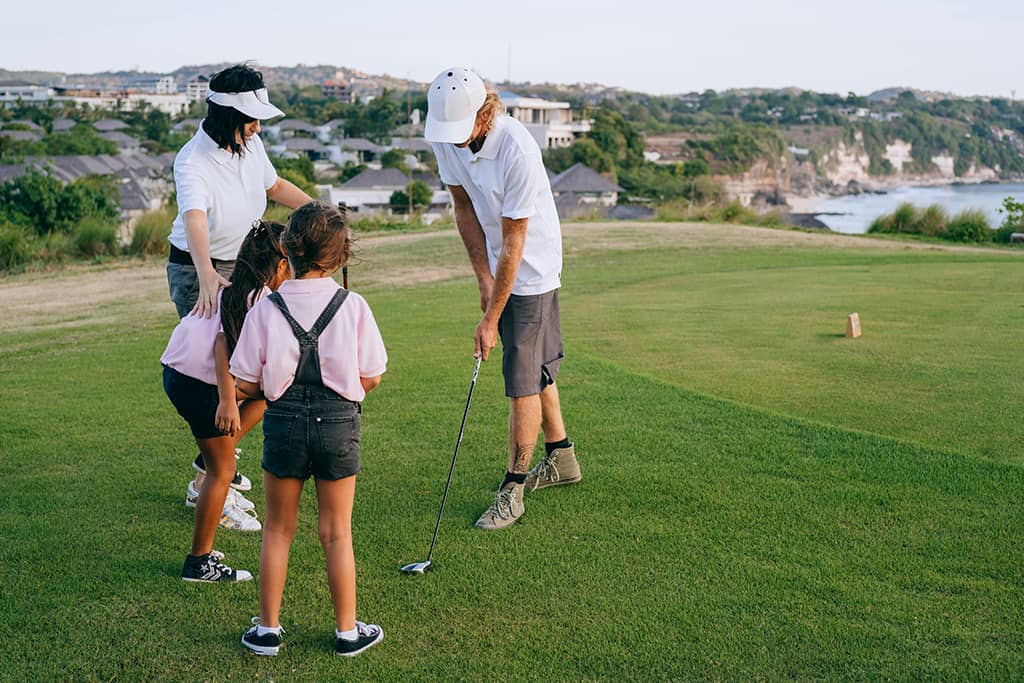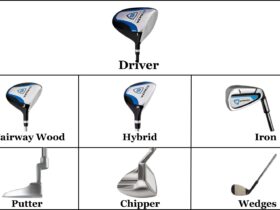Golf club distances vary based on the club type and the player’s skill level. Generally, drivers hit the farthest, while wedges cover shorter distances.
Understanding golf club distances is crucial for improving your game. Each club in your bag serves a specific purpose, from tee shots to precise short-game shots. Men usually hit drivers far, about 230 to 290 yards, while women hit them about 200 to 230 yards.
Irons and wedges cover shorter distances, with a 7-iron averaging 140-170 yards for men and 120-150 yards for women. Knowing these distances helps you choose the right club for each shot. This knowledge can improve your accuracy and overall performance on the golf course.
Introduction To Golf Club Distances

Understanding golf club distances is crucial for improving your game. Each club in your bag has a specific role and distance range. Knowing these can help you choose the right club for every shot.
The Role Of Clubs In Golf
Designers create golf clubs for various purposes. Drivers are for long-distance shots. Irons are for mid-range shots.
Wedges are for short, high shots. Putters are for rolling the ball into the hole.
A standard golf set includes:
- Driver: The club for the longest shots.
- Woods: For long-distance fairway shots.
- Irons: Numbered from 3 to 9 for various distances.
- Wedges: Including pitching, sand, and lob wedges.
- Putters: Used on the green for putting.
Why Distance Matters
Knowing your Golf Club Distances can greatly improve your game. It helps you select the right club for each shot. This increases your accuracy and confidence.
Here is a table showing the average distances for each type of club:
| Club | Average Distance (Yards) |
|---|---|
| Driver | 230-290 |
| 3-Wood | 210-250 |
| 5-Wood | 190-230 |
| 3-Iron | 180-210 |
| 4-Iron | 170-200 |
| 5-Iron | 160-190 |
| 6-Iron | 150-180 |
| 7-Iron | 140-170 |
| 8-Iron | 130-160 |
| 9-Iron | 120-150 |
| Pitching Wedge | 110-140 |
| Sand Wedge | 90-120 |
| Lob Wedge | 70-100 |
These golf Club distances are averages. Your actual distances may vary based on skill level and conditions. Practicing with each club can help you find your exact distances.
Golf Club Basics
Understanding golf Club Distances basics is crucial for improving your game. Each club has a specific purpose and design, affecting the distance and accuracy of your shots. Let’s dive into the essentials of golf clubs to help you make better choices on the course.
Types Of Golf Clubs
There are several types of golf clubs, each designed for a specific purpose. Here are the main types:
- Woods: Used for long-distance shots. These clubs have large heads and long shafts.
- Irons: Ideal for shorter shots. Irons have smaller heads and shorter shafts than wood.
- Hybrids: A mix of woods and irons. Hybrids offer flexibility and ease of use.
- Wedges: Designed for short, high shots. Wedges help you get out of tricky situations.
- Putters: Used on the green. Putters help you roll the ball into the hole.
Components Affecting Distance
Several factors affect the distance a golf club can achieve. Here are the key components:
| Component | Impact on Distance |
|---|---|
| Clubhead Speed | Higher speed results in longer distances. |
| Loft Angle | Lower loft angles produce longer shots. |
| Shaft Length | Longer shafts can generate more speed. |
| Clubhead Design | Modern designs can improve distance. |
Choosing the right club involves understanding these components. Each element plays a significant role in your performance.
Mastering these basics will help you select the right clubs and improve your game.
Distance Factors
Understanding golf club distances can improve your game. Many factors affect the distance your ball travels. Let’s explore the key elements that play a role in determining these distances.
Swing Speed
Swing speed is crucial for achieving optimal distances. Faster swing speed generally results in longer distances. Professional golfers often have higher swing speeds compared to amateurs.
Here is a table showcasing the average distances based on swing speed:
| Swing Speed (mph) | Average Distance (yards) |
|---|---|
| 60 | 150 |
| 70 | 175 |
| 80 | 200 |
| 90 | 225 |
Clubhead Design
Clubhead design influences the golf Club Distances and accuracy of your shots. Different designs offer various advantages. Here are some key aspects:
- Weight Distribution: Affects the balance and control of the club.
- Loft Angle: Higher lofts create more lift, leading to higher shots.
- Material: Modern clubs use materials like titanium for better performance.
Consider these factors next time you choose a club. They can help you achieve the desired distance and accuracy.
Measuring Your Distances
Understanding your golf club’s distances is key to improving your game. Knowing how far you can hit each club helps you make better decisions on the course. This section will guide you through measuring your distances accurately.
Tools And Techniques

To measure your distances, you need the right tools. A rangefinder or a GPS device is essential. These tools give accurate readings of how far your ball travels. You can also use a launch monitor for detailed data.
Another method is to use markers on the driving range. Note the distance to each marker and track how far your ball goes. This technique is simple and effective.
| Tool | Description |
|---|---|
| Rangefinder | Uses laser to measure distance |
| GPS Device | Uses satellite data for distance |
| Launch Monitor | Tracks ball speed, spin, and distance |
Tracking Progress
Keep a record of your golf Club Distances. Use a notebook or a golf app to track your progress. This helps you see improvements over time.
Here are some steps to follow:
- Hit 10 shots with each club.
- Record the average distance.
- Note any outliers and remove them from the average.
- Repeat this process every month.
Tracking your distances helps you understand your performance. You can make better club choices and improve your game.
Driver: The Powerhouse Club
Golfers often refer to the driver as the powerhouse club. It is the longest club in your golf bag. Designers create it to hit the ball the farthest.
This club is your best friend on the tee box. It can help you achieve maximum distance with your shots.
Understanding Driver Distances
Understanding driver golf Club Distances is crucial for improving your game. The average golfer hits a driver between 200 and 250 yards. Professional golfers can hit it over 300 yards. Your distance will depend on your swing speed, technique, and the club’s loft.
| Player Type | Average Distance (Yards) |
|---|---|
| Amateur | 200-250 |
| Professional | 300+ |
Maximizing Driver Performance
To maximize driver performance, pay attention to your grip, stance, and swing. Here are some tips to help you:
- Grip: Hold the club with a firm, yet relaxed grip.
- Stance: Stand with your feet shoulder-width apart.
- Swing: Keep your swing smooth and controlled.
Also, make sure to practice regularly. Use a launch monitor to track your progress. Adjust your technique based on the data.
Remember, consistency is key. The more you practice, the better your driver performance will be.
Table of Contents
Woods: Versatility Off The Tee
Woods are essential in every golfer’s bag. They provide unmatched flexibility and power. From tee shots to long fairway plays, woods are essential.
They help cover significant golf club distances with ease. Understanding their use can improve your game immensely.
Distances For Woods
Woods can cover impressive golf club distances. Here is a breakdown of the average distances:
| Type of Wood | Average Distance (Yards) |
|---|---|
| Driver | 230-300 |
| 3-Wood | 210-250 |
| 5-Wood | 180-230 |
| 7-Wood | 150-200 |
When To Use Woods
- Driver: Ideal for long-distance tee shots. Use wide fairways for maximum distance.
- 3-Wood: Great for fairway shots or shorter tee shots. Perfect for narrow fairways.
- 5-Wood: Best for long approach shots. It can also replace long irons.
- 7-Wood: Useful for shorter fairway shots. Good for getting out of roughs.
Irons: Precision And Control
Golfers seek precision and control with irons. These clubs help players hit accurate shots. They are essential for improving your golf game.
Irons come in different types and serve various purposes. Understanding their distances is crucial for success on the course.
Iron Distances Explained
Each iron has a specific distance range. Knowing these ranges helps you choose the right club. Here’s a table showing the average golf club distances for each iron:
| Iron | Distance (Yards) |
|---|---|
| 3-Iron | 180-210 |
| 4-Iron | 170-200 |
| 5-Iron | 160-190 |
| 6-Iron | 150-180 |
| 7-Iron | 140-170 |
| 8-Iron | 130-160 |
| 9-Iron | 120-150 |
These distances are averages. Your actual distances may vary. Factors like swing speed and weather affect your shots.
Choosing The Right Iron
Selecting the right iron is key. Follow these tips to make the best choice:
- Know Your Distance: Practice with each iron. Note the distances you achieve.
- Understand Course Layout: Study the course. Be aware of the location of hazards and obstacles.
- Consider Wind Conditions: Wind affects ball flight. Adjust your club choice accordingly.
- Check Lie of the Ball: The ball’s position influences your shot. Use a different iron for different lies.
- Practice Regularly: Consistent practice improves your Knowledge of each iron.
By following these tips, you can enhance your iron play. Your confidence and skill will grow with practice.
Hybrids: The Best Of Both Worlds
Hybrids are the perfect blend of irons and woods. They offer the accuracy of irons and the golf club distances of woods. Golfers love them for their versatility and ease of use.
Hybrids are great for long fairway shots and tricky lies. Their design helps you get the ball airborne quickly. This makes them ideal for beginners and experienced players alike.
Hybrid Distances
The distance you can achieve with a hybrid depends on the loft and your swing speed. Here’s a general idea of how far hybrids can go:
| Hybrid Club | Average Distance (Yards) |
|---|---|
| 2 Hybrid | 190-210 |
| 3 Hybrid | 180-200 |
| 4 Hybrid | 170-190 |
| 5 Hybrid | 160-180 |
Replacing Irons With Hybrids
Many golfers are now replacing their long irons with hybrids. Hybrids are easier to hit consistently. They provide better launch angles and more forgiveness.
Here are some reasons to consider replacing your irons with hybrids:
- Easier to hit from rough and fairway.
- Higher launch angle, which helps with distance.
- More forgiving on off-center hits.
- Versatile for various lies and conditions.
Switching to hybrids can improve your game and boost your confidence on the course.
Wedges: The Short Game Specialists
Wedges are the unsung heroes of the golf bag. They are essential for the short game. Their design helps golfers achieve precision and control. The unique loft angles make them perfect for pitching, chipping, and bunker shots.
Wedge Distances
Understanding the wedge of golf club distances is crucial for accuracy. Each wedge has a different loft angle, affecting the distance it covers. Here’s a table that breaks down the typical distances for each type of wedge:
| Type of Wedge | Loft Angle | Average Distance (Yards) |
|---|---|---|
| Pitching Wedge (PW) | 44°-48° | 110-140 |
| Gap Wedge (GW) | 50°-54° | 90-110 |
| Sand Wedge (SW) | 54°-58° | 70-90 |
| Lob Wedge (LW) | 58°-64° | 50-70 |
Mastering Wedge Shots
To master wedge shots, practice is key. Here are some tips to help you improve:
- Grip: Hold the club with a relaxed grip. This allows for better control.
- Stance: Keep a narrow stance. This improves balance and stability.
- Backswing: A shorter backswing helps with precision. Focus on a smooth transition.
- Follow-through: Ensure a full follow-through. This maintains consistency and accuracy.
Using wedges effectively can drastically lower your score. Remember, practice and patience are crucial. Keep these tips in mind, and your short game will improve.
Putters: The Final Stroke
In golf, the putter is often the most crucial club in your bag. Designers create this club for short, precise strokes on the green. It’s not about how far you hit the ball, but how accurately you can guide it to the hole. This makes understanding putter golf club distances essential for improving your game.
Average Putter Distances While golfers don’t use putters for long distances, understanding the average range remains valuable. Typically, golfers use a putter for the golf club distances within 30 feet. Here’s a quick breakdown:
| Distance | Usage |
|---|---|
| 0-5 feet | Short putts, high precision |
| 5-15 feet | Medium putts, balance of power and accuracy |
| 15-30 feet | Long putts, focus on control |
These golf club distances can vary based on skill level and green conditions. Practice is key to mastering these ranges.
Improving Putting Distance Control
Golf club distance control in putting is crucial for lowering your score. Here are some tips to help you:
- Focus on your grip: A consistent grip ensures better control.
- Practice your stroke: Regular practice helps develop a smooth, repeatable stroke.
- Read the green: Observe the slope and speed of the green before putting.
Using these techniques can significantly improve your putting distance control. Remember, patience and practice are your best tools.
Golf Club Distance Charts

Understanding your golf club distances can improve your game. A golf club distances Chart helps you know how far you hit each club. This knowledge aids in choosing the right club for each shot.
How To Read Distance Charts
A golf club distances chart shows the average distance for each club. These charts are useful for both beginners and pros.
Each row in the chart represents a club. The columns show the average distance. Here’s an example:
| Club | Average Distance (Yards) |
|---|---|
| Driver | 230 – 270 |
| 3-Wood | 210 – 250 |
| 5-Iron | 150 – 180 |
| 9-Iron | 90 – 130 |
Creating Your Personal Distance Chart
To create your chart, follow these steps:
- Go to the driving range and hit each club multiple times.
- Measure the distance of each shot.
- Note the distances and average them for each club.
- Record these averages in a chart.
Your chart will be unique to your swing and strength. Update it regularly for accuracy.
Factors Affecting Distance On The Course
Understanding the factors affecting your golf club distances can improve your game. Several elements come into play, influencing how far your ball travels. Let’s explore two primary factors: weather conditions and course terrain.
Weather Conditions
Weather conditions significantly impact your golf ball distance. Wind, temperature, and humidity can alter your performance.
- Wind: A strong headwind can reduce your ball’s distance. A tailwind can help it travel further.
- Temperature: Cold air is denser and can slow down your ball. Warmer temperatures can help your ball travel further.
- Humidity: Higher humidity levels can make the air less dense. This can cause your ball to travel further.
Keep an eye on the weather forecast before heading to the course. Adjust your strategy accordingly.
Course Terrain
Course terrain plays a vital role in determining your golf club’s distances. Different terrains present unique challenges.
| Terrain Type | Effect on Distance |
|---|---|
| Flat Terrain | Provides a consistent ball roll and predictable distances. |
| Hilly Terrain | Uphill shots reduce distance. Downhill shots increase distance. |
| Rough Terrain | Can slow down your ball. It may reduce overall distance. |
Understanding the terrain helps you choose the right club and strategy for each shot.
By considering these factors, you can make more informed decisions on the course. This can enhance your overall performance and enjoyment of the game.
Improving Your Golf Club Distances
Every golfer dreams of hitting the ball farther. Improving your golf club distances can transform your game. This involves both physical and technical enhancements. Below, we explore two key areas to focus on: strength training and technique refinement.
Strength Training
Strength training is crucial for increasing your golf club distances. Building muscle strength in key areas can lead to more powerful swings.
Focus on these muscle groups:
- Core muscles for stability and power.
- Leg muscles for a strong base and balance.
- Arm and shoulder muscles for swing control.
Incorporate these exercises into your routine:
- Planks and side planks for core strength.
- Squats and lunges for leg power.
- Push-ups and shoulder presses for upper body strength.
Technique Refinement
Improving technique is essential for better golf club distances. Proper technique ensures efficient energy transfer from your body to the club.
Key aspects of technique refinement include:
- Grip: A firm but relaxed grip.
- Posture: Balanced stance with slight knee bend.
- Swing mechanics: Smooth, controlled motion.
To refine your technique:
- Practice your grip and stance regularly.
- Work on a consistent swing path.
- Use video analysis to spot and correct flaws.
| Exercise | Target Muscle Group |
|---|---|
| Planks | Core |
| Squats | Legs |
| Push-ups | Arms and Shoulders |
Technology’s Impact On Distances
The game of golf has evolved tremendously due to technology. Players now hit the ball farther than ever before. Technology has influenced almost every aspect of the game. Let’s explore how advancements in club technology and golf simulators have increased the golf club distances
Advancements In Club Technology
Modern golf clubs are a marvel of engineering. Manufacturers use advanced materials like titanium and carbon fiber. These materials make clubs lighter and more durable.
Designers now consider airflow when designing club heads. This reduces drag and increases swing speed. More swing speed means more golf club distances.
Adjustable features on clubs let players tweak settings. They can change the loft, lie, and weight distribution. These adjustments optimize performance and distance.
Shaft technology has also improved. New shafts are lighter and more flexible. This allows for faster swings and longer shots.
Golf Simulators And Distance
Golf simulators have transformed practice routines. They provide accurate data on every shot. Players can see how far they hit each club.
Advanced sensors track swing speed, launch angle, and spin rate. Players use this data to adjust their technique. Improved technique leads to longer shots.
Simulators offer realistic course simulations. Players practice on famous courses worldwide. This helps them understand how to play different shots and increase their golf club distances.
Virtual coaching programs are also available. These programs analyze swings and offer improvement tips. Players can use these tips to increase their distances.
| Technology | Impact on Distance |
|---|---|
| Advanced Materials | Lighter, more durable clubs for faster swings |
| Adjustable Features | Optimized settings for longer shots |
| Improved Shaft Design | Faster swings and more distance |
| Golf Simulators | Accurate data for technique improvement |
| Virtual Coaching | Tips for increasing distance |
In summary, technology has significantly impacted golf club distances. Modern club designs and golf simulators provide players with tools to hit the ball farther. The game continues to evolve, and players benefit from these advancements.
Custom Fitting For Optimal Distances
Custom-fitting golf clubs can make a huge difference in your game. Using clubs that match your physical attributes and swing style helps you achieve the best possible golf club distances. Custom fitting ensures tailoring each club in your bag to your needs.
Benefits Of Custom Fitting
Custom fitting offers several benefits for golfers of all skill levels:
- Improved Accuracy: Clubs that fit your specifications and help you hit the ball more accurately.
- Consistent Distance: Achieve consistent distances with each swing.
- Better Comfort: Clubs that match your body type and swing feel more comfortable.
- Enhanced Confidence: Knowing your clubs are perfectly fit boosts your confidence.
The Fitting Process
The fitting process involves several steps to ensure your clubs are just right:
- Initial Assessment: A professional fitter evaluates your swing and physical attributes.
- Club Selection: Based on the assessment, the fitter recommends club types and models.
- Shaft Fitting: The fitter chooses the right shaft length, flex, and material.
- Grip Fitting: The fitter selects a grip size that feels comfortable in your hands.
- Final Adjustments: The fitter makes any necessary tweaks to ensure a perfect fit.
Age And Distance: Adapting Your Game

Golf is a sport where players of all ages can excel. As you age, your golfing needs and abilities change. Adapting your game based on age can improve your performance. This section explores the golf club distances for senior and junior golfers.
Senior Golfers
Senior golfers often face a decline in swing speed. This can affect how far they hit the ball. To maintain golf club distances, it helps to use clubs with more loft. Hybrid clubs can also be beneficial.
- Use lighter clubs: Helps with swing speed and control.
- Focus on technique: Proper form can compensate for reduced power.
- Regular practice: Keeps your skills sharp and improves consistency.
Junior Golfers
Junior golfers are still growing and developing their skills. They may not have the strength of adult players. Choosing the right equipment is crucial for young golfers.
| Age | Club Type | Distance (Yards) |
|---|---|---|
| 5-7 | Driver | 60-80 |
| 8-10 | Iron | 50-70 |
| 11-13 | Wedge | 40-60 |
- Shorter clubs: Easier to handle and control for young players.
- Lightweight clubs: Helps build confidence and technique.
- Regular lessons: Ensures proper development of skills.
Women’s Golf Club Distances
Understanding women’s golf club distances can greatly improve your game. Each club has a specific distance range. Knowing these ranges helps in making better shot decisions.
Differences In Women’s Clubs
Designers create women’s golf clubs differently from men’s clubs. They are usually lighter and shorter. The shafts are more flexible, making it easier to swing.
| Club | Average Distance (Yards) |
|---|---|
| Driver | 180-200 |
| 3-Wood | 160-180 |
| 5-Iron | 130-150 |
| 7-Iron | 110-130 |
| Pitching Wedge | 70-90 |
Maximizing Distance For Women
To maximize distance, focus on the basics. Maintain a good posture and grip. Use your whole body to generate power.
- Proper Stance: Keep your feet shoulder-width apart.
- Grip: Hold the club firmly but not too tight.
- Swing: Use a smooth and controlled swing.
Choosing the right club is also crucial. Select clubs that match your swing speed and strength. This ensures you get the best golf club distances and accuracy.
By knowing the distances of each club, you can plan your shots better. This leads to improved performance and lower scores.
Golf Distance Myths Debunked
Many golfers believe in myths about golf club distances. These myths can mislead beginners. Let’s debunk some common misconceptions and set realistic expectations.
Common Misconceptions
Myth 1: Pros hit every club further than amateurs. Many think the pros hit a 7-iron over 200 yards. Reality: Pros focus on accuracy, not just distance.
Myth 2: New clubs always add distance. Some believe buying the latest club adds 20 yards. Reality: Technique and practice matter more than new clubs.
Myth 3: Swinging harder means more distance. Many think a powerful swing boosts distance. Reality: Control and form are key to distance.
Realistic Expectations
Average Golfers’ Distances: Here’s a table showing average golf club distances for amateur golfers:
| Club | Average Distance (Yards) |
|---|---|
| Driver | 200-230 |
| 3-Wood | 180-210 |
| 5-Iron | 150-170 |
| 7-Iron | 130-150 |
| Pitching Wedge | 90-110 |
Focus on Consistency: Aim for consistent distances with each club. Practice and proper form are more important than raw power. Track your progress with a golf app or journal.
Understand Your Limits: Know your current abilities. Set goals based on personal performance. Avoid comparing yourself to pros.
Use Technology Wisely: Golf simulators and launch monitors can help. They provide data to improve your game. Invest in lessons with a coach for personalized advice.
Summary: Myths can mislead golfers about distances. Focus on accuracy, consistency, and realistic goals. Use technology and coaching to improve.
Practice Drills For Increased Distances

Improving your golf club distances requires dedication and practice. By Adding specific drills into your routine, you can see significant improvements. This section focuses on two key areas: driving range routines and on-course drills.
Driving Range Routines
The driving range is the perfect place to work on increasing your distances. Here are some routines to get you started:
- Warm-Up Properly: Start with light stretching and a few easy swings.
- Use Alignment Sticks: Place sticks on the ground to ensure your stance is correct.
- Practice with Different Clubs: Rotate between drivers, irons, and wedges.
- Focus on Technique: Pay attention to your grip, stance, and swing path.
- Track Your Progress: Use a range finder or app to measure distances.
On-course Drills
Practicing on the course helps translate range improvements into real play. Try these drills during your next round:
- Play from Different Tees: Use various tee boxes to challenge yourself.
- Simulate Course Conditions: Practice shots from rough, fairway, and bunkers.
- Use a Golf GPS: Measure distances and track your shots.
- Focus on Ball Contact: Ensure clean, solid hits for maximum distance.
- Play with Purpose: Set goals for each hole to improve focus.
By implementing these practice drills, you can see improvements in your golf club distances.
Maintaining Consistency In Your Distances
Golfers strive for consistency in their game, particularly in their club distances. Achieving steady distances with each club is crucial for lowering scores and improving performance. Here, we explore key strategies to maintain consistency in your golf club distances.
Mental Approach
Your mental approach can significantly impact your performance. Focus on the shot at hand rather than the overall game. This helps in reducing pressure and anxiety.
Visualize each shot before swinging. Picture the ball’s path and landing spot. This mental imagery can enhance your confidence and execution.
Avoid dwelling on past mistakes. Stay present and concentrate on your current shot. This mindset promotes consistency and improves your overall game.
Pre-shot Routines
A consistent pre-shot routine is essential for steady golf club distances. Develop a routine that you can repeat for every shot.
Here’s a simple pre-shot routine to follow:
- Assess the situation: Check wind direction, distance, and obstacles.
- Select your club: Choose the club that matches the distance and conditions.
- Grip and stance: Ensure your grip and stance are consistent.
- Visualize the shot: Imagine the ball’s flight path.
- Take a practice swing: Mimic the shot you want to execute.
- Execute the shot: Focus on the ball and swing with confidence.
Following a structured routine can reduce flexibility in your shots. It helps create a rhythm and boosts your confidence.
Additional Tips
| Tip | Description |
|---|---|
| Keep a log | Record your distances with each club. This helps in tracking progress. |
| Practice regularly | Frequent practice helps in honing your skills and maintaining consistency. |
| Use alignment aids | Alignment aids ensure your stance and aim are correct. |
Maintaining consistency in your golf club distances is a blend of mental focus, structured routines, and regular practice. Implement these strategies, and watch your game improve.
Conclusion: Playing Smarter With golf club distances Knowledge
Understanding the golf club distances of your golf clubs can dramatically improve your game. This knowledge helps you make better decisions on the course. Using this information wisely can lower your scores and make you a more confident player.
Strategic Course Management
Effective course management is crucial for every golfer. Knowing your club distances lets you plan each shot with precision. This reduces the risk of hazards and maximizes your strengths. For example, if you know your 7-iron goes 150 yards, you can confidently select it for shots at that distance. This understanding helps you avoid bunkers, water, and other obstacles.
| Club | Average Distance (Yards) |
|---|---|
| Driver | 230 |
| 3-Wood | 210 |
| 5-Iron | 180 |
| 7-Iron | 150 |
| Pitching Wedge | 120 |
Continuous Learning And Adjustment
Golf is a game of continuous improvement. Tracking your distances helps you learn and adjust. Use a rangefinder or GPS to measure your shots during practice rounds.
Keep a record of your golf club distances in different conditions. This data helps you make informed decisions on windy or rainy days. Re-evaluate your distances as your skills improve. Update your club distances every few months.
By focusing on these aspects, you can play smarter and more effectively. This will lead to better scores and more enjoyable rounds of golf.
Frequently Asked Questions
How Many Yards Should Each Club Go?
Each club’s distance varies by golfer. On average: Driver: 230-290 yards, 3-wood: 210-250 yards, 5-wood: 195-225 yards, 4-iron: 170-210 yards, 5-iron: 160-200 yards, 6-iron: 150-190 yards, 7-iron: 140-180 yards, 8-iron: 130-170 yards, 9-iron: 120-160 yards, Pitching wedge: 110-150 yards.
How Many Yards Should A 7-iron Hit?
A 7-iron typically hits between 130 to 160 yards. Golf club distances vary based on player skill and conditions.
Should I Carry A 5-wood Or 3-hybrid?
Choose a 5-wood for longer, higher shots on fairways. Opt for a 3-hybrid for versatility and easier hits from rough.
How Far Can Tiger Woods Hit A 5 Iron?
Tiger Woods can typically hit a 5-iron around 200 yards. His distance can vary based on conditions and technique.
What Are The Standard Golf Club Distances?
Standard distances vary by club type and player skill.
How Far Can A Driver Hit?
A driver can hit between 230 – 290 yards.
What Is The Average Distance For A 7-iron?
The average 7-iron distance is 140-170 yards.
How Far Does A Pitching Wedge Go?
A pitching wedge typically goes 110-130 yards.
What Is The Distance For A 3-wood?
A 3-wood can cover 210-230 yards.
How Far Can A 5-iron Hit?
A 5-iron hits approximately 160-180 yards.
Conclusion
Mastering golf club distances improves your game. Practice regularly to understand each club’s range.
Track your progress and make adjustments. This knowledge boosts confidence in the course. Enjoy lower scores and a more enjoyable golfing experience.
Happy Golfing!






I recently discovered an fascinating article on golf gear that I feel would capture the attention of everyone enthusiastic about the sport. The piece delves into the newest developments in golf gear, showcasing the top clubs, golf balls, and accessories for both beginner and experienced players. It contains detailed evaluations and contrasts of multiple brands and models, offering insights into their operation, durability, and cost-effectiveness: Golf Gear Recommendations
Whether you’re aiming to upgrade your existing gear or just interested about what’s new in the industry, this article is definitely worth a read. It also provides tips on how to select the right gear based on your game style and experience. For those who are committed about improving their play or just wish to stay updated with the latest developments in golf gear, this is a must-check-out. Have a read and see how the proper gear can make a significant difference on the field.